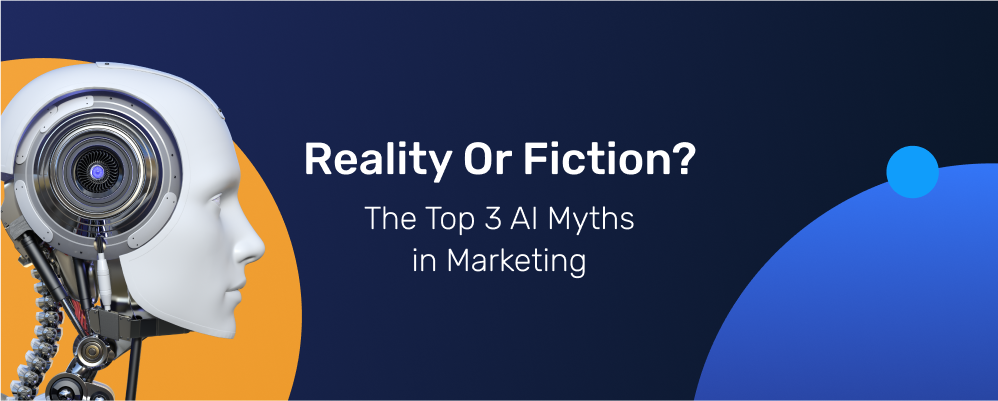
Nice to have you back, dear truth seekers! We’re back for another installment of our LinkedIn Live Broadcast event series where we pick the minds of marketing experts to bring you the scoop on industry trends. We know you’re hungry for more myth-busting facts, and we’re here to dish them out. You’ll love today’s specialty: artificial intelligence.
The AI revolution is upon us. It’s expected to mirror the previous three industrial revolutions that changed the world as we know it: steam power, electricity, and computing. Unsurprisingly, people want to learn more about this rapidly evolving technology. But with all the myths going around, it’s getting hard to pin down the hard facts.
We’ll be making a lot of references to a recent myth-busting interview carried out by Olha Olifirenko, Product Marketing Lead at Retainly, to dispel myths and shed light on the reality of marketing. In this episode, she talks with Andrey Burlutskiy, CMO, a Fan of Our Future, IT Showman, and Entrepreneur.
The former Microsoft colleagues worked through the AI myths so we can better understand what’s real and what’s not.
Let’s get down to it.
Myth #1: AI in Marketing is Too Expensive for Small Businesses
Although AI has been around for a while now, some still regard it as the new kid in town — mysterious and inaccessible. It remains a pipe dream for many businesses, particularly the smaller ones. But the reality is that AI tech is pretty accessible, thanks to the software-as-a-service (SaaS) model.
Accessible SaaS and subscription models
The SaaS software delivery method allows users to access solutions online via subscription.
Here’s how it works: software providers allow you to use the software in the cloud without time- and energy-consuming installations. Users also benefit from the pay-as-you-go model many SaaS products follow.
Andrey put things into perspective as he gave us a rundown of the popular AI solutions and just how much (or how little!) they actually cost. And you’ll have to agree — with a subscription model, there’s no such thing as expensive software anymore.
He mentioned the following examples of AI solutions and their estimated monthly rates:
Looking at these rates, it’s easy to see how a small business can have a professional marketing technology stack for only $300-500 per month.
Once you get to know these services, you’ll realize they aren’t so out-of-reach after all.
Increased productivity and earnings
AI becomes even less costly once you consider its potential returns. With the right use cases, you can leverage the technology to increase productivity and drive revenue.
A recent McKinsey Global Survey reveals 27% of respondents attribute 5% of their earnings before interest and taxes (EBIT) to AI. Moreover, 61% of employees report increased productivity resulting from AI adoption, and 68% want their employers to adopt even more AI technology.
If you think AI scares people with Terminator scenes, that’s rarely the case. As a matter of fact, 89% of employees believe AI could lighten up their workload by half, while 81% believe it enhances their overall work performance. It’s a welcome change, clearly.
The question is — are companies ready to adopt and implement AI? We’ll tackle this question in the next myth-busting section.
Myth #2: AI in Marketing is Too Complex and Difficult to Implement
We’re dealing with 50 shades of AI when it comes to the question of whether the technology is hard to adopt or not. Unsurprisingly, Andrey was not quick to bust this myth. For it has as much truth to it as falsehood.
AI platforms vary in complexity. You could say AI is challenging and dynamic, and you wouldn’t be wrong. You could point to its accessibility and ease of use, which are also true. Between 50% and 60% of companies are now using AI, a rate that has more than doubled since 2017. Although the adoption rate has risen, many companies still struggle to integrate technology into their processes.
Andrey points to the four common barriers:
You should bear in mind that small businesses don’t always need the same AI stack as the leading marketing tech companies. Such businesses should take a closer look at their needs using the following models:
Problem-based model
Instead of trying to adopt complex or multiple solutions all at once, you can determine a key problem area and focus on that. For instance, you may identify retention as a key area for improvement in your company. Instead of adopting a large-scale CRM solution, you can opt for smaller platforms like Retainly, which automates engagement to help you scale your retention efforts.
User case model
It helps to be specific when describing which processes or user behavior you’d like to change. This way, you can make targeted and impactful changes. This approach is more doable and practical than overhauling the entire workflow. After all, you won’t need to go from all manual to fully autonomous to see massive returns. For instance, a small business may want to start small by using ChatGPT to automate social media interactions, messaging, and inquiries.
The key here is to ease into the process. Get this right, and you’ll be well on your way to being an AI powerhouse.
Myth #3: AI in Marketing Will Replace Human Creativity
AI is unquestionably intelligent, but is it also creative? Will it drive marketing roles into oblivion? Should you be worried?
This is another myth that we’re not outright busting. Neither does Andrey. While he acknowledges the speed by which AI can generate ideas, concepts, articles, emails, posts, and YouTube scenarios, he stresses how it’s still limited by the breadth of resources available on the Internet (all of which have been made available by humans). And since it automates certain marketing tasks, it can and will phase out a number of marketing roles.
But here are some reasons why AI can never completely replace human creativity:
AI is a tool to enhance human creativity, not replace it
Instead of fearing AI, you should lord it over. Treat it like the tool that it is. Just as a car can speed up getting you from point A to point B, so can AI.
Instead of spending too much time on repetitive tasks like data analysis and email outreach, you can devote more attention to planning new strategies, tactics, and campaigns. Without routine tasks bogging you down, you’ll have more bandwidth for work that feeds your company’s bottom line.
AI requires human guidance and oversight
Sure, AI can automate tasks and offer suggestions, but it can only do these things in response to prompts added by humans. And it’s still down to their human masters (yes, that’s you!) to ultimately make the creative decisions.
As mentioned by Andrey, AI’s output is limited to and biased by the input provided by humans. On the other hand, humans have more leeway to discover information as they please and use the stimuli to keep their creative juices flowing freely.
AI lacks emotional intelligence
Effective marketing touches people on an emotional level. While AI does a great job of analyzing data and automating tasks, it can’t replicate people’s ability to understand human emotions and motivations. Even the so-called emotional AI can only make interpretations based on facial and tonal expressions and is unable to take into account underlying social and cultural context.
Want a message that truly resonates with your target audience? Your resident marketing guru will still do a better job than your unempathetic AI platform.
Top Lead Generation Tools to Help You Unleash the Power of AI
We’ve helped you work through the AI myths. Now, you may be wondering which AI tools to add to your own tech stack. We’re here to help you with that as well.
Industry experts Ohla and Andrey were kind enough to share a list of AI lead-generation tools that can take your marketing campaigns to the next level. And we’re including it here:
Neurons. Woo your prospects with campaigns and ads that resonate. Let Neurons be the wing guy that tells you when your moves are working and when you need to pivot.
Leadfeeder. Companies are already checking out your website. Use Leadfeeder to ensure you’re catching their deets and turning them into leads.
Copy.ai. You’ll never be tongue-tied or confronted by a blank page with Copy.ai churning out copy that sends the right message and converts.
Reply. Engage your prospects with multichannel sequences that capture attention. You can also count on Reply to keep the conversations going.
Grammarly. Thanks to Grammarly, you can confidently approach your prospects with messages free of embarrassing typos and grammatical errors.
Retainly. Make sure your customers are sticking around with a retention tool that uses data-driven strategies and omnichannel engagement to keep them interested.
Bonus: ChatGPT is your new friend. Just enter some prompts to get humanlike responses in text, image, and video formats.
So, which platforms do you need to integrate into your business processes? Take the cue from Andrey and use the problem-based or user-case model to answer that question.
So, what can you take away from our myth-busting?
We hope tackling the top three AI myths has helped you get past your inhibitions and hesitations. You may see now that even small businesses can afford an AI stack. And although the technology can be complex, you can always ease into the adoption process until you have a well-oiled system. You may even stop worrying about AI undermining your creative work.
Just keep exploring AI to dispel even more fears and learn to take advantage of the technology.

